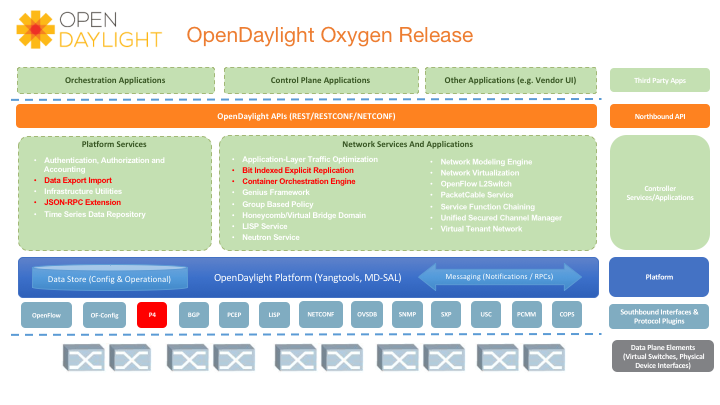
OpenDayLight (ODL) stands as the most pervasive open-source SDN controller platform, with a score of 84.5% in our comprehensive evaluation and the largest community support in the market. Designed from the outset as a foundation for commercial solutions, ODL excels in cloud integration scenarios, particularly with OpenStack, Kubernetes, OPNFV, and ONAP—making it the de facto choice for telco cloud and NFV environments.
This is part of our comprehensive SDN Controller Comparison Guide, where we evaluate 6 leading open-source controllers across 13 technical criteria.
OpenDayLight at a Glance
| Attribute | Details |
|---|---|
| Overall Score | 84.5% (Ranked #2) |
| Best For | Cloud integration, SD-LAN, telco NFV, data centers |
| Architecture | Modular, three-layer with OSGi |
| Programming Language | Java |
| Primary Protocols | OpenFlow, P4, NETCONF, SNMP, BGP, RESTCONF, PCEP |
| Clustering | Native (AKKA datastore) |
| Community | Linux Foundation Networking (largest community) |
| Key Differentiator | Broadest ecosystem integration (OpenStack, K8s, ONAP) |
| Deployment Complexity | High (feature-rich = more complexity) |
| License | Eclipse Public License 2.0 |
What OpenDayLight Does Best:
- Largest open-source SDN community and ecosystem
- Native integration with cloud platforms and orchestrators
- Most extensive plugin and project ecosystem
- Model-driven architecture with YANG support
- Production-proven in telco NFV deployments
Architecture Deep Dive
ODL consists of 3 layers:

- Southbound plugins to communicate with the network devices
- Core Services that can be used by means of Service Abstraction Layer (SAL) which is based on OSGi to help components going in and out of the controller while the controller is running
- Northbound interfaces (e.g. REST/NETCONF) that allow operators to apply high-level policies to network devices or integration of ODL with other platforms
Modularity and Extensibility
Built-in mechanisms provided by ODL simplify the connection of code modules. The controller takes advantage of OSGi containers for loading bundles at runtime, allowing a very flexible approach to adding functionality.
Scalability
ODL uses a model-based approach, which implies a global, in-memory view of the network is required to perform logic calculations. ODL’s latest release further advances the platform’s scalability and robustness, with new capabilities supporting multi-site deployments for geographic reach, application performance and fault tolerance.
- ODL contains internal functionality for maintaining a cluster, AKKA as a distributed datastore shares the current SDN state and allows for controllers to failover in the event of a cluster partition
- As a cluster grows however, communication and coordination activities rapidly increase, limiting performance gains per additional cluster member
Architectural Scalability
- ODL includes native BGP routing capabilities to coordinate traffic flows between the SDN islands
- Introduction of OpenDaylight into OpenStack provided multi-site networking while boosts networking performance
Interfaces
- Southbound: It supports an extensive list of Southbound interfaces including OpenFlow, P4, NETCONF, SNMP, BGP, RESTCONF and PCEP.
- Northbound: ODL offers the largest set of northbound interfaces with gRPC and RESTful APIs. The northbound interfaces supported by ODL include OSGi for applications in the same address space as the controller and the standard RESTful interface. DLUX is used to represent Northbound interfaces visually to ease integration and development work.
Telemetry
At a project level, ODL has limited telemetry related functionality. With the latest development release, there are moves toward providing northbound telemetry feeds, but they are in early design and not likely to be ready for production in the short term.
Resilience and Fault Tolerance
ODL fault tolerance mechanism is similar to ONOS, with an odd number of SDN controllers required to provide fault tolerance in the system. In the event of master node failure, a new leader would be selected to take the control of the network. The mechanism of choosing a leader is slightly different in these controllers – while ONOS focuses on eventually consistent, ODL focuses on high availability.
Programming Language
From a language perspective, ODL is written in Java.
Community
ODL is the second of the SDN controllers under the Linux Foundation Networking umbrella. This project has the largest community support of all open source SDN controllers in the market, with several big-name companies actively involved with development.







